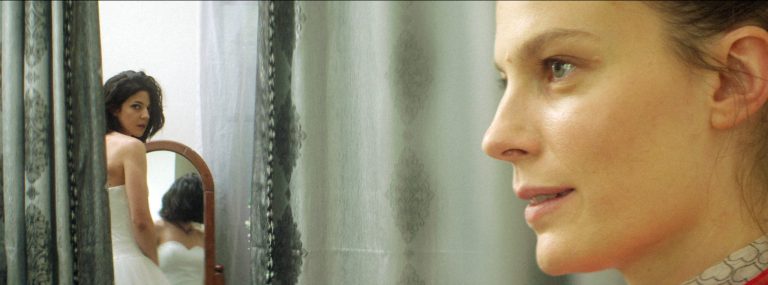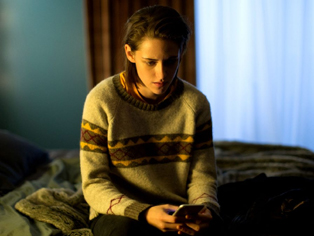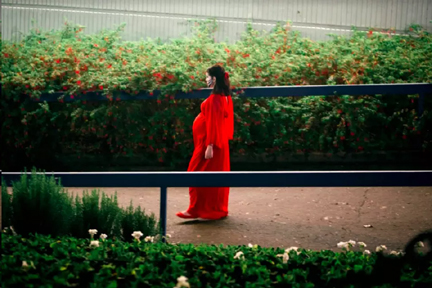FILM REVIEWS ROUNDUP - w/DE PALMA MENTIONS
THIRST STREET, FREE FIRE, UNFORGETTABLE, THE ASSIGNMENT
Here's a roundup of recent movie reviews and essays mentioning
Brian De Palma in one way or another:
Rodrigo Perez on Thirst Street (The Playlist)
"To keep it indie 100 for a minute and hopefully not sound too obscure, if indie filmmaker Alex Ross Perry was to
Roman Polanski what his paranoiac feature Queen Of Earth was to Polanski’s The Tenant, then director Nathan Silver is to Rainer Werner Fassbinder what Thirst Street is to the German New Wave director’s Lola. Plus, well, throw in a little additional devilish Polanski for good measure, too.
Don’t be confused. This is all to say director Nathan Silver’s latest feature, the Euro-arty-influenced Thirst Street, a wry and disturbed look at lust and longing, is a terrific, vintage homage, and a deliciously arch little treat (and made by Washington Square Films, the same company that produced Queen Of Earth). Starring the exceptional and fetching Lindsay Burdge (A Teacher), who walks a thin line of heightened melodrama, sly comedy and sincere emotional distress, the actress carries the brittle movie on her back, but never falters while sticking the landing of its tricky tenors.
"In the vein of psychosexual thrillers of the ’80s or ’90s, with a ’70s throwback twist, Silver’s reading is more psychosexual comedy, as Thirst Street is slippery and mischievous in its depiction of anxiety and obsession — an easy cliff to fall off if you’re going to paint your heroine as a shrill nut job. Thankfully, Thirst Street is too smart and artful for that.
"Burdge stars as Gina, a emotionally despondent flight attendant reeling from the loss of her fiancé who, in a lonely, paranoid and jealous fit at her long stretch of absences away from home, suddenly committed suicide. Sweet but emotionally off-center from the tragedy, Gina sticks close to her flight attendant gal pals as they hit Paris for a brief overlay. Wallflowering through an evening of drinks, her friends bribe a tarot-card reader to bring her good fortune. The fortuitous moment changes her mood and eventually lands her in the arms of Jérôme (Damien Bonnard), a charming and sophisticated French louche (who doesn’t look dissimilar to Gina’s ex). A one-night stand ensues and really, that should be it, but a magical connection is made, at least for Gina, which sends her on a possessed mission to find Jérôme and essentially insinuate herself into his life. Quickly unhinged, Gina falls head over heels, over heels and over heels. It’s a glorious splatter, a warped tour through 1970s, European-flavored psychodramas, again, many of which Polanski was the grandmaster of. Throw in a soupçon of feathery fantasy, a DePalma diopter shot or two and sweaty Serge Gainsbourg lecherousness, and the recipe is complete.
"Narrated with delectable dry and deadpan wit by Anjelica Huston (an awesome get whose value to the tone cannot be understated), her purposefully emotionless, hilarious delivery is your first clue as to the askew nature of the movie. Esther Garrel co-stars as Clémence, an ex-girlfriend who becomes increasingly annoyed with Gina’s unwanted and ubiquitous presence.
"Shot by venerable indie DP Sean Price Williams (Heaven Knows What, Listen Up Philip, Queen Of Earth), the cinematographer must have had a blast imitating Fassbinder’s Douglas Sirk-inspired look from Lola (DP Xaver Schwarzenberger) and its dreamy gaze and saturated colors. Williams is just one of the many contributors here that elevate already rich material. Visually, Thirst Street is enchanting, expressing with bold feeling all of Gina’s strange obsessions. Composer Paul Grimstad’s gauzy and atmospheric soundtrack only bolsters the fraught and theatrical mood."
Katie Walsh on Unforgettable (Los Angeles Times)
"Unforgettable is tawdry, sometimes cheesy, and definitely soapy. There are some insane choices made in the production design, which is actually perfect for a movie like this. It’d be all too easy to write it off as 'guilty-pleasure' material, a higher-budget Lifetime movie. But that would denigrate female-driven entertainment that deals with the melodramas of the mind, body and soul from a woman’s perspective. Though this movie has its outrageous moments, Di Novi puts the female emotional journey front and centre and treats things respectfully.
"But every erotic thriller needs some crazy, and thank goodness for Heigl’s full commitment to her character’s insanity. That campiness is needed in a picture like this, allowing the audience relief from the tension while we giggle at her enthusiastic hair brushing or wild-eyed mania. In a final scene, she’s swathed gloriously in a mint caftan, her hair flowing. She calls to mind that other unforgettably controlling mother, Margaret White, from Brian De Palma’s 1976 film Carrie, played by Piper Laurie, who earned an Oscar nomination for that role. Heigl channels Laurie’s performance with her lilting tones and soft savagery. It’s a uniquely feminine kind of villainy that’s transfixed us since classical Hollywood, and Di Novi and Heigl understand it implicitly in order to execute it perfectly."
David Edelstein on Free Fire (Vulture)
"But Wheatley, for all his gifts, doesn’t quite hit his marks. Free Fire cries out for a spatial-temporal genius like Brian De Palma — though I imagine De Palma would have quickly gotten bored with the limited premise. When all hell breaks loose, you lose your bearings (who is with whom?), and the van that crashes with the still-blaring John Denver 8-track cassette is a good comic idea made excruciating by … too much John Denver. The movie is meant to be a nihilist joke, but it’s all fodder if you don’t give a damn about who’s being annihilated."
Jeff Simon recalls 1991 press screening of Reservoir Dogs (The Buffalo News)
Wheatley admits Scorsese was partly responsible for him becoming a filmmaker in the first place. Having Scorsese around to advice him during the making of "Free Fire" was a rarity. Compared to having to deal with a studio executive, it was like being steadied by "a kindly hand rather than a niggling presence." Where does all this droll movie excess come from?
Consider Toronto's Varsity Theater a quarter of a century ago. It was, in 1991, a shabby, dirty and unhealthy room to begin with but, on this day, it was so full of people that some were trying to sit on the floor. It's a "Press and Industry Screening" for the film that was that year's buzz champion, Quentin Tarantino's "Reservoir Dogs."
The room is packed with "press and industry" people from all over the world -- people who don't give a fig for luxury or comfort when the prospect of seeing a great film is nigh. Rex Reed sat directly behind me. Filmmaker Brian DePalma sat a couple seats in front of me and to the left. By the time we were all watching Michael Madsen merrily dancing around to Stealer's Wheel's "Stuck in the Middle With You" and slicing a bound cop's ear off, it was obvious that we were experiencing a new way of portraying movie criminals and the violent, sadistic things they do.
If sadism wasn't a defining characteristic of their endeavors, stupidity might be. That notion fully entered the pop cultural worldview in 1985 with the advent of the Coen Brothers' first film "Blood Simple." But some other things happened in that theater on that day.
--- Film Festivals -- and the kind of international "Press and Industry" people they attract -- were confirmed as a new audience for cinematic innovation in commercial films (not just art films.) In this case, it was ultra-violent excess conveyed with sardonic humor.
--- A new kind of film intellectual was born. Tarantino was a film intellectual from the video store, not the library or the cinematheque. There was very little that was bookish about him. He'd seen all these movies because he was a store clerk, not because a library told him to and a cinematheque scheduled them for him to see.
Wheatley likes to tell people that he's influenced by Tom and Jerry. He is, himself, a former animator. "Free Fire" then is taken from all kinds of sources, he said. "Silent cinema. And Hanna Barbera cartoons. And things like that." And it's what happens when you take it all "full throttle."
That's because in the movies of 2017, "full throttle" visuals don't have to be translated into other languages. Accents are so thick in "Free Fire" that a good 25 percent of the dialogue is incoherent. It scarcely matters. You know what you're watching, whether you live in Roanoke or Rangoon or Reykjavik.
When you've had part of a career in animation, you're familiar with a movie world of violence that doesn't affect characters. Think of all the things that happened over the decades to poor Wile E. Coyote in Chuck Jones' seven-minute masterworks about The Road Runner.
At the same time, Wheatley points out that there's a crazy kind of realism to "Free Fire" -- the difficulty, for instance, of hitting a moving target when you're shooting, and the ability of people to keep going after getting hit with many gunshots. "It's not unrealistic," says the man whose basic idea for the movie came from an FBI report talking about that very thing.
And, as he says, nice things and happy endings are "well-covered in America" at the movies and on TV, but "actual reality is not so well covered."
Armond White on The Assignment (National Review)"The Assignment is less thrilling than [Walter] Hill’s career comeback Bullet to the Head (2012). The Assignment’s imperfection cannot be overlooked: Actress Michelle Rodriguez doesn’t achieve Frank’s androgynous potential. Her full-frontal nude strut is as phony as Mark Wahlberg’s rubber phallus in Boogie Nights, and she portrays Frank’s machismo with the same sullen sneer that reviewers foolishly equated with Brando in Rodriguez’s debut film, Girlfight (2000). Scenes with a working-class nurse (Caitlin Gerard) make Rodriguez’s acting limitations painfully apparent. Frank should have been as fascinating as the cross-gender characters in Pedro Almodóvar’s The Skin I Live In, Brian De Palma’s Raising Cain, or Hill’s plastic-surgery classic Johnny Handsome, in which Mickey Rourke movingly portrays a man whose facial reconstruction reveals the good or evil potential in those around him. As bold as The Assignment is, Hill nonetheless must struggle with Hollywood’s sexual sanctimony."
 The Guardian's Peter Bradshaw on Yorgos Lanthimos' The Killing Of A Sacred Deer
The Guardian's Peter Bradshaw on Yorgos Lanthimos' The Killing Of A Sacred Deer





 Julia Ducournau's directorial debut, Raw, opened a couple of weekends ago. Several reviews have mentioned Brian De Palma, as well as other filmmakers, as potential influences, and specifically De Palma's Carrie and Sisters, in relation to Raw. In the first link/excerpt below, Ducournau explains to Dan at Geekadelphia why Carrie was the only consciously deliberate reference she made to any film. Following that are links to other reviews of Raw:
Julia Ducournau's directorial debut, Raw, opened a couple of weekends ago. Several reviews have mentioned Brian De Palma, as well as other filmmakers, as potential influences, and specifically De Palma's Carrie and Sisters, in relation to Raw. In the first link/excerpt below, Ducournau explains to Dan at Geekadelphia why Carrie was the only consciously deliberate reference she made to any film. Following that are links to other reviews of Raw: Hot on the heels of
Hot on the heels of 


 Alice Lowe discusses her directorial debut, the horror comedy Prevenge, with
Alice Lowe discusses her directorial debut, the horror comedy Prevenge, with